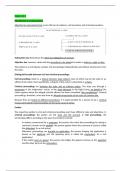Study Unit 1
Introduction to civil procedure
Adjective law (procedural law) covers the law of evidence, civil procedure and criminal procedure.
Substantive law determines the rights and obligations of persons.
Adjective law, however, deals with the procedure to be adopted in order to enforce a right or duty.
The parties to a civil dispute conduct civil proceedings independently and without interference from
the state.
Distinguish broadly between civil and criminal proceedings:
Civil proceedings relate to a dispute between legal subjects (one of which may be the state or an
official of the state). More specifically, a dispute of this nature is described as a claim.
Criminal proceedings are between the state and an ordinary citizen. The state acts through a
prosecutor in the magistrates’ courts, or the state advocate in the High Courts, on behalf of the
citizen against whom the alleged criminal offence has been committed (the complainant). Criminal
proceedings, therefore, arise only from an alleged transgression of the rules of common law.
Because they are based on different procedures, it is quite possible for a person to lay a criminal
charge and institute civil proceedings on the same cause of action.
Parties:
The respective parties to civil and criminal proceedings each have different roles and objectives. In
criminal proceedings, the parties are the state and the accused. In civil proceedings, the
terminology differs according to the type of procedure involved.
- In matters commenced by a summons, the person who starts the proceedings by issuing a
summons is known as the plaintiff; the person against whom the summons is issued is called
the defendant. (In a civil action)
- Whenever proceedings are brought on application, the person bringing the application is
known as the applicant and the opposing party is called the respondent. (In a civil
application)
- If the matter goes on appeal, the person who lodges the appeal is known as the appellant
and the other party as the respondent.
,An accused who is found guilty of a criminal offence is usually punished either by means of a fine or
imprisonment or both. A defendant or respondent who is found liable in a civil matter must usually
pay damages (money) or perform some service for the plaintiff or applicant
Civil matters are essentially private in nature. If the parties fail to pursue a matter, the state, or the
court for that matter, will not intervene. For this reason, the plaintiff or applicant, as the case may
be, is known as dominus litis, which means the ‘lord’ or ‘master’ of the litigation. Nothing will
happen unless the plaintiff or applicant (usually with the help of his or her attorney) takes steps to
initiate the various processes. Although the state may be one of the parties in a civil matter, it is
regarded as being on an equal footing with any other private individual or juristic person.
Onus of proof
In civil proceedings, the burden of proof is on a balance of probabilities. This means that the court
must be satisfied that the version put forward by the plaintiff/applicant is more probable than that
put forward by the defendant/respondent.
The burden of proof in criminal proceedings is far more stringent than in civil proceedings. The onus
is on the state to prove beyond all reasonable doubt that the accused committed the offence as
charged.
Other areas of civil law, such as delict and contract, tell you whether or not you have a valid legal
claim, whilst civil procedure tells you precisely how to go about enforcing that claim. The respective
bodies of law relating to delict and contract, for example, are each part of substantive law, whereas
civil procedure is part of procedural (sometimes referred to as adjectival) law.
Civil law covers a much wider area than criminal law, civil procedure is wider in scope, and more
complex, than criminal procedure. No single right existing outside of criminal law can be enforced
without the use of civil procedure. Civil procedure and criminal procedure are both heavily
influenced by the law of evidence.
Remember that the names of the magisterial districts are not always the same as the names of the
courts that serve them. Remember also that a single magisterial district may include more than one
municipal area.
The Constitutional Court consists of the Chief Justice of South Africa, the Deputy Chief Justice, and
nine other judges. The Constitutional Court sits in Johannesburg. When the court was established, it
was a specialist court, which dealt purely with constitutional matters. In a few (very limited) cases, it
was also possible to approach the Constitutional Court as a court of first instance. Currently, this is
still the case when the matter falls within the Constitutional Court’s exclusive jurisdiction or when
the matter justifies direct access to the Constitutional Court. It is now the highest court of appeal for
all matters, constitutional and non-constitutional, where it functions as a court of first and final
instance. Still required to confirm any declaration of invalidity made by the Supreme Court of Appeal
or by any division of the High Court.
The officials
The most senior judge in the country is the Chief Justice. At the time of writing the third edition of
this book, the Chief Justice of South Africa is Justice Mogoeng Mogoeng, who succeeded Justice
Sandile Ngcobo. Chief Justice Mogoeng Mogoeng also presides as chairperson of the Judicial Service
Commission (or often referred to as the ‘JSC’), the body that is responsible for the selection of
judges.
,At the time of writing the third edition of this book, the Deputy Chief Justice of South Africa is Justice
Dikgang Moseneke who will be retiring from the bench soon. When reading a current law report,
you will see the letters ‘DCJ’ after his name.
The President of the Supreme Court of Appeal is the most senior judge of that court. He carries the
letter ‘P’ after his name in the law reports. At the time of writing the third edition of this book, the
President of the Supreme Court of Appeal is Justice Lex Mpathi. The Deputy President of the
Supreme Court of Appeal carries the letters ‘DP’ after her name. At the time of writing the third
edition of this book, the Deputy President of the Supreme Court of Appeal is Justice Mandisa Maya,
the first female judge to occupy the position.
As far as the High Court is concerned, usually the most senior judge within a certain (provincial)
division is appointed as the Judge President. These judges carry the letters ‘JP’ after their names in
the law reports. The other High Court Judges carry the letter ‘J’ after their names. Judges of the High
Court are still addressed in court by making use of the expressions ‘My Lord’ (M’Lord), ‘My Lady’
(M’Lady), ‘Your Lordship(s)’ and ‘Your Ladyship(s)’.
The presiding officers in the District and Regional Magistrates’ Courts are, of course, magistrates. In
court, a magistrate should be addressed as ‘Your Worship’
The equivalent official in each of the District Magistrates’ Courts is known as the clerk of the court.
In the Regional Magistrates’ Courts, such official is known as the registrar of the court. These officials
are dealing with all the administrative work related to civil litigation.
Legal documents in both the High Court and Magistrates’ Court are delivered by the sheriff of the
court. This official and his deputies also perform other duties such as carrying out civil arrests and
attaching the goods of debtors.
The bill of costs that is drawn up at the end of most civil matters is dealt with by the taxing master.
STUDY UNIT 2
Sources of civil procedural law
Magistrates’ courts consist solely of statutory provisions and rules of court; (decided cases and
rules)
High Court consists of statutory provisions, rules of court and common-law rules
The following statutes are the main statutory sources for purposes of civil procedure: (also referred
to as “primary legislation”)
• The Superior Courts Act 10 of 2013 (which replaced the Supreme Court Act 59 of 1959)
• The Magistrates’ Courts Act 32 of 1944
• The Constitution of the Republic of South Africa, 1996
Until 1965, the various divisions of the then Supreme Court had different Rules of Court for different
divisions. With effect from 15 January 1965 proceedings have been conducted uniformly in all the
divisions of the then Supreme Court – now the High Courts – under a common set of Rules, which
are still known as the Uniform Rules of Court.
Section 25 of the Magistrates’ Courts Act of 1944 similarly. The present magistrates’ courts rules
came into operation on 30 August 1968.
, The present Supreme Court of Appeal Rules were promulgated on 15 December 1961.
This background information explains the important change that occurred in 1985. The Supreme
Court of Appeal, as well as for the various High Courts, was conferred upon Rules Board for Courts
of Law Act 107 of 1985. This also applied in respect of the rules for magistrates’ courts.
The Rules Board was established in 1985. The members of the board are appointed by the Minister
of Justice for a period of five years and are eligible for reappointment. The rules of court for both
courts contain annexures that set out the forms prescribed by the rules. These forms contain the
wording of various processes mentioned in the rules. This is done for the benefit of litigants and
legal practitioners, as well as to maintain uniformity and consistency. The rules of court have
statutory force and are therefore binding on a court.
STUDY UNIT 3
Civil procedure in context
Because it is part of the system of Anglo-American civil procedure, a dominant characteristic of
South African civil procedure is that it adheres to the adversarial system of litigation. All South
African courts of law, except the small claim’s courts, apply adversarial principles and procedures.
A basic understanding can be gained of an adversarial system by briefly comparing the application of
adversarial litigation with Continental procedure.
Continental civil procedure is characterised as being inquisitorial, the inquisitorial system is common
in many countries with a civil law system.
Characteristics of the Continental system: In the inquisitorial system,
- The judicial officers participate directly in the process of litigation along with the parties,
judicial officers are actively involved in the conduct of proceedings and in determining the
facts of the case.
- “pleadings” are in the form of notices to the parties and include evidence; in certain
instances, judicial officers are involved in the gathering of evidence.
- The trial is in the form of a hearing in which a judicial official may participate actively by
asking questions, and sometimes by leading evidence.
In contrast, Anglo-American civil procedure is adversarial in nature. It is a system generally adopted
in common-law countries
Characteristics of the Anglo-American system:
- The system regards litigation as a private matter and relies on the legal representatives of
parties to prosecute their respective claims or defences.
- The legal representatives are also responsible for gathering and presenting their evidence to
a judicial official at trial.
- The trial in Anglo-American civil procedure is marked by its orality (it is predominantly oral in
nature). This means that viva voce evidence (oral evidence given by witnesses in person) is
led by the counsel for both litigants by means of examination, cross-examination and re-
examination.
- proceedings are marked by distinct pre-trial and trial stages





